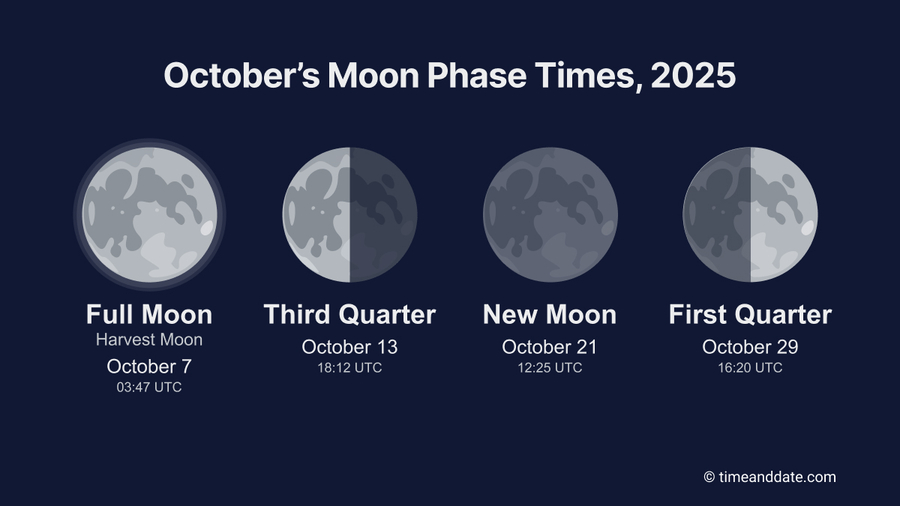
When to See the Full Moon in October
October’s Full Moon is at its most illuminated at 03:47 UTC on October 7, 2025.
The Moon always appears full in the days before and after peak illumination. Full Moon is the only phase where the Moon is up all night, with moonrise and moonset occurring around sunset and sunrise.
See where the Moon is right nowMoon Phase Times October 2025
| Moon Phase | Date | Time |
|---|---|---|
| Full Moon | October 7 | 03:47 UTC |
| Third Quarter | October 13 | 18:12 UTC |
| New Moon | October 21 | 12:25 UTC |
| First Quarter | October 29 | 16:20 UTC |
Moon phases are divided into primary and intermediate: Primary Moon phases happen at a specific moment in time, while the intermediate Moon phases occupy the times in between.
Why is the Harvest Moon in October?
It’s natural to think that the Harvest Moon has been given its name because of the harvest season in the Northern Hemisphere, but then why is it sometimes in September, and sometimes in October?
The answer lies with the September equinox, which is the autumnal (fall) equinox in the Northern Hemisphere—this year on September 22 at 18:19 UTC.
Full Moons rise around sunset, and, on average, about 50 minutes later each day. But when a Full Moon happens close to the autumnal equinox, the difference in the time between moonrise from one night to the next becomes less than 50 minutes. As a result, the time of moonrise stays closer to the time of sunset. So, for several nights in a row, there’s extra moonlight in the evenings. In the past, this gave farmers more time to harvest crops.
It’s the other way around in the Southern Hemisphere as it is the spring equinox in September. At Full Moon—or close to Full Moon—the difference in moonrise time is more than 50 minutes, and we have the opposite of the Harvest Moon effect described above.
The Moon & Planets in October
In October, the Moon does the rounds and meets up with Saturn, Jupiter, and Venus. And as a bonus for those in the Southern Hemisphere, it also meets Mars and Mercury.
On the night of October 5–6, the almost Full Moon meets up with Saturn. With your back to the sunset, look for the pair rising together as the sky darkens at dusk—but you can see them side by side all night like in New York, USA, and London, UK. In Sydney, Australia, the pair are closest at dawn, just before sunrise.
The Third Quarter Moon finds Jupiter on the night of October 14. In New York and London, the pair rise around midnight and will be visible until sunrise. The pair are up in Sydney from about 03:00 (3 am) to sunrise.
Around October 19, the thinnest Crescent Moon finds Venus. Venus is often found near a Crescent Moon. This is because the New Moon rises and sets at the same time as the Sun. Venus lies closer to the Sun than Earth, which means it never strays too far from the Sun. So, as the Moon is at its Crescent phase, the celestial bodies appear closer, generally just before sunrise or just after sunset.
At this time, Venus is further from the Sun in its cycle, and is visible in the morning—affectionately known as the “morning star”. You can have a look at our Night Sky simulation for New York, London, and Sydney.
Bonus in Australia & New Zealand: The Waxing Crescent Moon, Mercury, and Mars triangulate in the evening sky. See the trio just after sunset on October 23, like in Sydney and Wellington. But be careful: Do not try to observe objects close to the Sun while any part of the Sun is above the horizon. Never point binoculars or a telescope in the direction of the Sun—it can cause permanent eye damage.
Harvest Moon Celebrations
As explained above, this month’s Full Moon is the Harvest Moon, and several countries celebrate this special Full Moon as a holiday. In South Korea, Chuseok is celebrated near the Harvest Moon. Also, Chinese and Vietnamese communities celebrate the Mid-Autumn Festival.
Frequently Asked Moon Questions
When is the next Full Moon?
This month’s Full Moon is on October 7 at 03:47 UTC. The next Full Moon in 2025 is on November 5 at 13:19 UTC, and is a Supermoon.
Does the Full Moon affect moods?
Overall, there has been little hard evidence to prove that the Moon has a measurable effect on human physiology and behavior.
When was the last Blue Moon?
The last Blue Moon was on August 16, 2024, and the next Blue Moon is on May 31, 2026.
